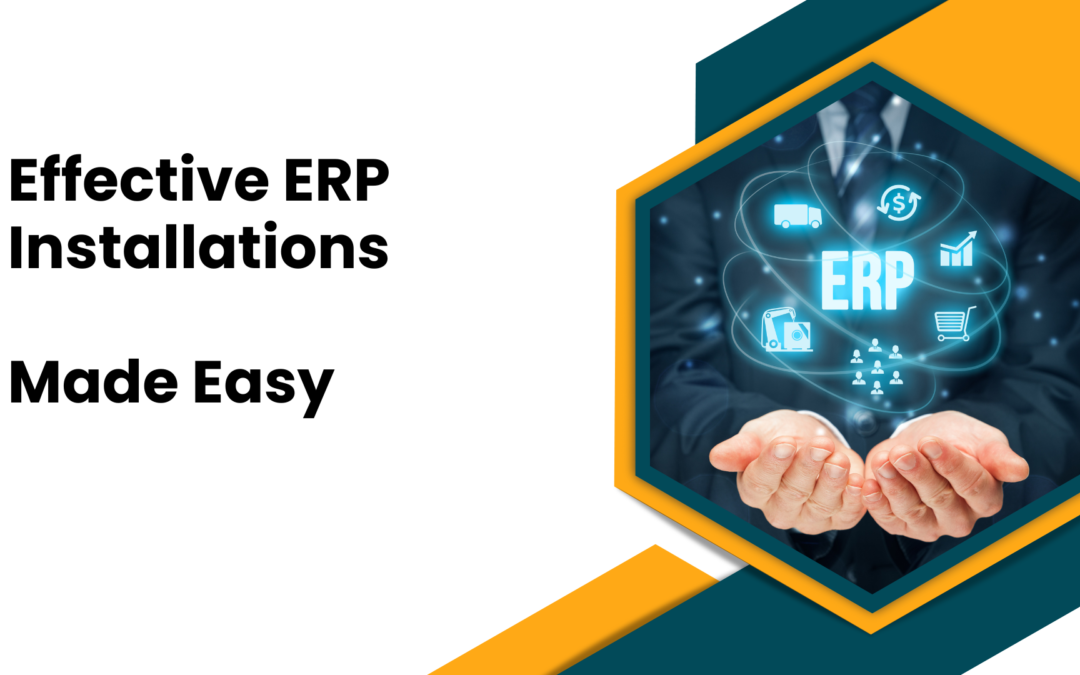Navigating the ERP Implementation Landscape
Embarking on an Enterprise Resource Planning or ERP implementation can be daunting for organisations of any size. From selecting the right software to managing implementation timelines, numerous challenges exist at every stage of the implementation process. However, with careful planning and execution, an ERP project can revolutionise your business processes and drive organisational efficiency.
First things first – Understanding ERP
Before you implement an ERP solution, it’s crucial to understand the comprehensive nature of ERP. At its core, ERP integrates various business functions, such as finance, human resources, supply chain management, and customer relationship management, into a unified system. This comprehensive approach ensures that all aspects of your business are covered, giving you a holistic view of your operations and empowering you to make informed business decisions.
Why do organisations need ERP Solutions?
In today’s competitive landscape, ERP is not just a luxury but a necessity for organisations aiming to stay agile, efficient, and competitive. By integrating core business functions like finance, HR, inventory, and supply chain management into a single system, ERP fosters seamless communication and collaboration across departments. It provides real-time insights into key metrics, enabling informed decision-making and strategic planning. Moreover, ERP automates repetitive tasks, reduces manual errors, and optimizes resource allocation, resulting in cost savings and increased productivity.
ERP implementations and solutions across industry verticals
As organizations recognise the transformative potential of integrated management systems, more and more industry verticals are opening up to implement ERP solutions for better business management and scalability. Here’s how ERP is being leveraged across various sectors:
Healthcare:
- Patient Care Coordination: ERP systems centralise patient data, enabling healthcare providers to access comprehensive medical records efficiently. This facilitates seamless coordination among different departments and improves the quality of patient care.
- Regulatory Compliance: With stringent regulations like HIPAA (Health Insurance Portability and Accountability Act), healthcare providers require robust systems to ensure compliance. ERP solutions offer features like secure data storage, audit trails, and automated reporting to meet these stringent regulatory requirements.
- Resource Optimization: Effective resource management, including staff scheduling, inventory control, and equipment maintenance, is vital in healthcare settings. ERP systems optimise resource allocation, minimise waste, and enhance operational efficiency across the organisation.
Education:
- Student Management: ERP solutions streamline student enrollment, registration, and academic records management. They provide a centralised platform for tracking student progress, managing grades, and facilitating communication between students, faculty, and administrators.
- Financial Management: Educational institutions must manage complex financial operations, including budgeting, procurement, and accounting. ERP systems automate financial processes, ensure transparency, and enable efficient resource allocation.
- Curriculum Planning: ERP systems assist in curriculum development, course scheduling, and classroom assignment. They help educational institutions effectively adapt to changing curriculum requirements and student needs.
Construction:
- Project Management: ERP solutions provide comprehensive project management tools for construction companies, including project planning, scheduling, and resource allocation. They enable real-time project progress tracking, cost control, and risk management.
- Supply Chain Optimization: In the construction industry, efficient supply chain management is essential to ensure timely delivery of materials and equipment. ERP systems integrate supply chain processes, from procurement to inventory management, enhancing efficiency and reducing costs.
- Compliance and Safety: Construction projects are subject to various regulations and safety standards. ERP systems help companies ensure compliance with regulatory requirements, track safety protocols and manage documentation efficiently.
Preparing for Success: Key Pre- ERP Implementation Steps
Thorough planning sets the stage for every seamless and successful ERP implementation journey. Here are some initial steps that will help you understand your ERP requirements better:
- Defining Objectives and Requirements
The foundation of any successful ERP project lies in clearly defining objectives and requirements. Start by identifying pain points in your current processes and outlining the desired outcomes of the ERP implementation. Engage stakeholders from across the organisation to ensure alignment and gather comprehensive requirements.
- Selecting the Right ERP Solution
Choosing the appropriate ERP solution is a critical decision that requires thorough research and evaluation. Consider factors such as scalability, customisation options, industry-specific functionality, and vendor reputation. Engage in demonstrations and consultations with potential vendors to assess how well their solutions align with your business needs.
- Building a Competent Project Team
An ERP project requires collaboration across various departments, from IT to finance to operations. Assemble a cross-functional project team of individuals with diverse expertise and perspectives. Assign clear roles and responsibilities to each team member and ensure strong leadership to drive the project forward.
ERP Implementation: Precision, Perfection
As with any major software, implementing an ERP solution is a significant change for any organisation. Here’s how you can ensure that your implementation is a success from the get-go:
- Detailed Planning and Scheduling
Develop a comprehensive project plan that outlines timelines, milestones, resource allocation, and dependencies. Break down the implementation process into manageable tasks and establish clear accountability for each deliverable.
- Data Migration and Cleansing
Data migration is often one of the most challenging aspects of ERP implementation. Thorough cleansing and validation procedures ensure data accuracy and integrity. Also, develop a robust data migration strategy for legacy systems, data mapping, and transformation requirements.
- Customization and Configuration
While ERP solutions offer a range of out-of-the-box features, customisation may be necessary to align the system with your unique business processes. Work closely with your vendor to configure the ERP system according to your specifications. Strike a balance between customisation and standardisation to minimise complexity and maintenance efforts.
- Testing and Quality Assurance
Rigorous testing is essential to identify and address issues before the ERP system goes live. Develop comprehensive test cases covering all functional areas and scenarios. Conduct iterative testing cycles, including unit testing, integration testing, and user acceptance testing, to validate system performance and functionality.
- Training and Change Management
Practical training and change management are paramount to ensure user adoption and minimise resistance to change. Develop tailored training programs for end-users at all levels of the organisation. Provide hands-on training sessions, user manuals, and online resources to empower employees to leverage the full capabilities of the ERP system.
Go-Live and Post-Implementation Support
A Go-live is the most crucial time for any implementation team. As your ERP system is rolled out across the organisation, you must ensure that your colleagues keep using the software to iron out any issues found during production. Here’s what you can do to keep the system ship-shape post-launch:
- Smooth Transition to Production
The go-live phase marks the culmination of the ERP implementation journey. Execute a carefully orchestrated cutover plan to seamlessly transition from legacy systems to the new ERP environment. Monitor system performance closely during the initial days post-go-live and address any issues promptly to minimise disruptions.
- Continuous Improvement and Optimization
ERP implementation is not a one-time event but an ongoing journey of continuous improvement. Establish mechanisms for gathering user feedback and monitoring system performance post-implementation. Identify opportunities for optimisation and enhancement through additional customisation, integration with third-party systems, or process refinement.
How can Clavis Technologies Help?
Clavis has extensive experience in various industry verticals, such as construction, healthcare, banking, insurance, government, and more. With its world-class ERP solution, Clavis Technologies can help organisations leverage their ERP software to boost organisational growth, streamline business operations, and transform employee experiences.
Driving Business Transformation with ERP
Executing an ERP project requires meticulous planning, collaboration, and execution. By following the steps outlined in this guide and leveraging ERP best practices, organisations can unlock the full potential of ERP systems to drive business transformation, enhance operational efficiency, and stay ahead in today’s competitive landscape. Embrace the challenges and opportunities of ERP implementation with Clavis Technologies and confidently embark on your journey towards operational success.
ERP vs CRM: Key Differences, Strengths, and How Clavis’ ERP Drives Organizational Success
In the digital age, businesses strive to leverage advanced tools to streamline operations, boost productivity, and foster better customer relationships. Two pivotal software solutions that play a significant role in achieving these goals are Enterprise Resource Planning (ERP) and Customer Relationship Management (CRM) systems. While these tools may seem similar at first glance, they serve distinct purposes and offer unique benefits, and it is important to understand why you may need one or the other—or both in tandem.
1. What is ERP?
ERP stands for Enterprise Resource Planning, a comprehensive software suite that manages and integrates core business processes. These processes often include:
- Finance and accounting
- Human resources
- Supply chain management
- Inventory and order management
- Manufacturing
ERP systems centralise business data, allowing various departments to collaborate seamlessly and make informed decisions based on real-time insights.
Core Features of ERP Systems
- Centralized Data Management: Consolidates information from all business departments into one platform.
- Process Automation: Automates repetitive tasks to improve efficiency.
- Scalability: Can grow with your business, accommodating new functionalities as needed.
- Compliance Support: Helps organisations meet regulatory requirements.
- Advanced Analytics: Provides detailed insights to support strategic decision-making.
2. What is CRM?
CRM, or Customer Relationship Management, is software that focuses on managing a company's interactions with current and potential customers. The primary goal of a CRM system is to improve customer satisfaction, retention, and acquisition through personalised communication and efficient management of sales and marketing activities.
Core Features of CRM Systems
- Contact Management: Maintains detailed records of customer interactions and preferences.
- Sales Pipeline Tracking: Manages leads and monitors the sales process.
- Marketing Automation: Facilitates email campaigns, social media management, and more.
- Customer Support: Enhances post-sale services through ticketing systems and live chats.
- Data-Driven Insights: Helps identify trends to fine-tune marketing and sales strategies.
3. ERP vs. CRM: Key Differences
While ERP and CRM are essential for business success, they cater to different aspects of operations.
|
Feature |
ERP |
CRM |
|
Primary Focus |
Internal processes and operational efficiency |
Customer interactions and relationships |
|
Key Functions |
Accounting, supply chain, HR, inventory |
Sales, marketing, customer service |
|
Target Audience |
Internal stakeholders |
Sales, marketing, and customer support teams |
|
Data Integration |
Focuses on consolidating operational data |
Specialises in customer-centric data |
|
Scalability |
Enterprise-wide |
Primarily focused on customer management |
4. The Strengths of ERP Systems
ERP systems are the backbone of operational efficiency. Their key strengths include:
- Holistic Business View: ERP provides a comprehensive view of business operations by integrating data across departments.
- Cost Reduction: Automating processes reduces manual labour and errors, saving time and money.
- Improved Compliance: Centralized data simplifies regulatory reporting and ensures adherence to standards.
- Inventory Optimization: Enhances inventory management, reducing waste and ensuring timely procurement.
- Agile Decision-Making: Real-time data insights help leaders make swift, informed decisions.
5. The Strengths of CRM Systems
CRM systems shine in the realm of customer relationship management, with benefits such as:
- Enhanced Customer Insights: Tracks and analyses customer preferences to tailor interactions.
- Improved Customer Retention: Personalization and timely communication foster loyalty.
- Streamlined Sales Processes: Automates lead management, reducing manual intervention.
- Marketing Optimization: Helps segment audiences for targeted campaigns.
- Boosted Collaboration: Facilitates alignment between sales and marketing teams.
6. ERP and CRM: Complementary Tools
Though distinct, ERP and CRM systems are complementary and often integrated to deliver maximum value. For instance:
- CRM manages the front-end relationship with customers, while ERP handles back-end processes like inventory and order fulfilment.
- Together, they provide a seamless flow of information, ensuring that customer-facing teams have accurate, up-to-date data on orders and services.
7. Clavis' ERP: The Ultimate Solution for Organizational Success
Clavis' ERP stands out as a robust ERP solution designed to address the multifaceted needs of modern businesses. Here’s how it can drive your organisation's success:
a) Comprehensive Integration
Clavis' ERP integrates seamlessly with existing systems, including CRM platforms, to unify your business processes.
b) Real-Time Data Analytics
With Clavis' ERP, decision-makers can access advanced analytics tools that offer actionable insights into performance, trends, and potential opportunities.
c) Tailored Functionality
Highly customisable to suit the unique needs of businesses across industries, Clavis' ERP works for all—from manufacturing to retail and more.
d) Enhanced User Experience
The platform boasts an intuitive interface, making it easy for employees to adopt and use effectively.
e) Cloud Capabilities
Leverage cloud-based deployment for flexibility, scalability, and cost savings.
9. Choosing the Right Solution for Your Business
When deciding between ERP and CRM—or opting for an integrated approach—consider the following:
- Business Goals: Identify whether your primary focus is operational efficiency (ERP) or customer relationships (CRM).
- Scalability: Choose a solution that can grow with your business.
- Budget: Evaluate the total cost of ownership, including deployment and maintenance.
- Customization: Ensure the platform can be tailored to your specific needs.
Final Thoughts
ERP and CRM systems are indispensable for businesses aiming to optimise operations and enhance customer relationships. While they serve distinct purposes, their integration offers unparalleled value. With Clavis' ERP, you gain a robust tool that streamlines your operations and integrates seamlessly with CRM systems to provide a holistic business solution.
Some other posts you might be interested in.

Mauritius and MNIC 3.0 – Driving the Digital Transformation in East Africa
On February 26, 2024, the Prime Minister of Mauritius, Mr Pravind Kumar Jugnauth, unveiled MNIC 3.0, the latest iteration of the Mauritius National Identity card. Speaking on the occasion, the Prime Minister stated, “The new card reflects our commitment to modernity,...

CMS and DAM: Why your business needs both
With the enhancement of technology, consumers require flawless experiences in everything they do. Be it at home, with their smartphone, car, or work-space, the ease of handling tasks should be at the snap of a finger. To have a seamless experience at the workspace,...

15 Applications of Blockchain in Healthcare
"Blockchain" refers to a shared irreversible record of a chain of transactions, each of which is made up of one block, and which is held together by cryptographic keys ("hashes"). These keys or signatures are maintained in shared ledgers and connected by a network of...
